
A wasp nest was dangling from the edges of one of the signs at the carpark. And what a strange-looking nest it was!
We are often more familiar with the nests built by hornets, vaguely round masses constructed out of a mixture of plant fibers and saliva, with the combs protected from the elements by a covering.

Nest of lesser banded hornet (Vespa affinis);
(Photo by NatureInYourBackyard)
However, in many wasp species, the combs are open, and the developing larvae and pupae can be observed by those cautious/brave/crazy enough to take a closer look.
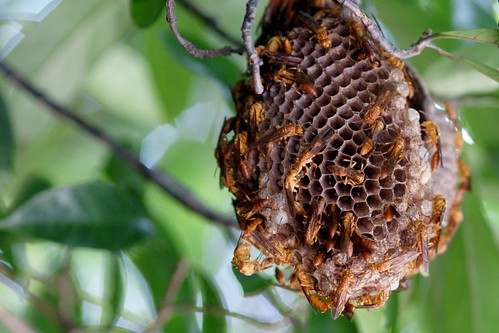
Nest of lesser paper wasp (Parapolybia indica);
(Photo by leositt)
This particular nest took the form of a long dangling rope, and measured about 30 centimetres in total length.
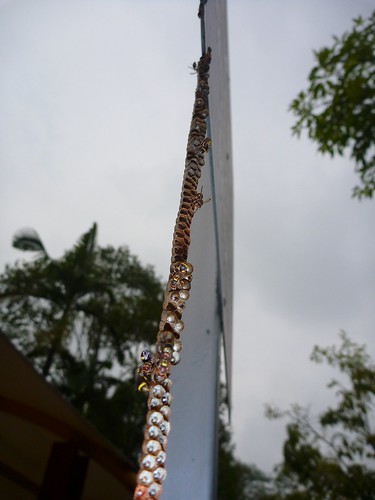
Here's a closeup shot of some of the open cells. You can see the larvae.
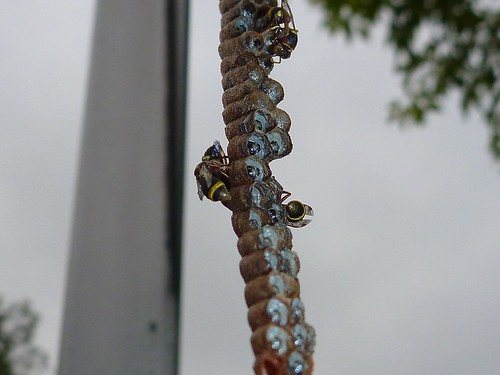
After a bit of searching, I soon found out that these are paper wasps belonging to the genus Ropalidia. Here is a page with more info about Ropalidia, which apparently consists of many species distributed across tropical Asia and Africa. Based on comparisons with photos and a checklist of Ropalidia species, this could be Ropalidia fasciata, a species with a wide distribution across tropical and subtropical Southeast Asia. For ease of communication, I will assume that the wasps I encountered were indeed Ropalidia fasciata, and will refer to this species as the banded paper wasp.
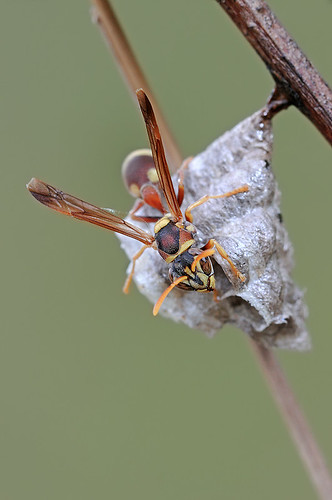
(Photo by y_leong23 )
Ropalidia, like all other social wasps, belong to the Vespidae. While the large species of vespids are commonly known as "hornets", many of the smaller species are known as "paper wasps", due to the papery material used to construct their nests, which is made from wood pulp. Adult wasps rip off and chew bits of wood from trees, rotten logs, and even man-made wooden structures, mixing these fragments of wood with saliva until they are soft. This pulp is then applied in layers to the surface, and dries to form a tough paper. It's not as elegant as say, the wax cells built by their relatives the bees, but it still forms a lightweight yet durable structure for the colony.
Yellow paper wasp (Polistes rothneyi) worker gathering nest material, Japan;
According to John Lee, who runs the Asian Hornet Net website, Ropalidia wasps do not present much of a threat when colonies are small; the adults are usually quick to flee when disturbed. However, once the colony is large enough, the wasps will defend their nest quite aggressively. Considering the small size of the adult wasps, the stings can be quite painful. This is a rare occurrence though, since they will attack only when physical contact is made with the colony, such as when people unknowingly brush against it or poke it out of curiosity. Indeed, the wasps were highly tolerant of my presence, even though I was quite close to the nest (though I was not touching it), and went about their business without harassing me.

As for diet, the adults, like all other social wasps, subsist entirely on a liquid diet, relying on nectar and secretions from their own larvae. Hornets and paper wasps can be aggressive hunters of other insects, but it is solely meant for the larvae, which are carnivorous. In the case of Ropalidia wasps, John has observed them catching caterpillars and small flies.
The wasps pictured in the following photos are likely to be banded paper wasps.
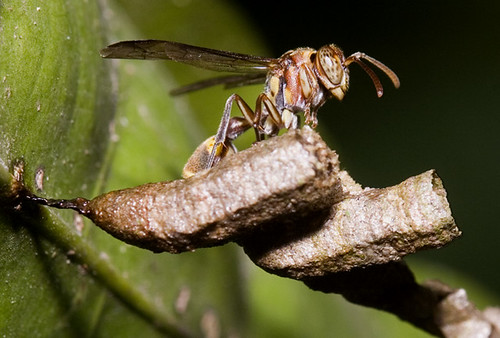
(Photo by Marcus)

(Photo by Marcus)
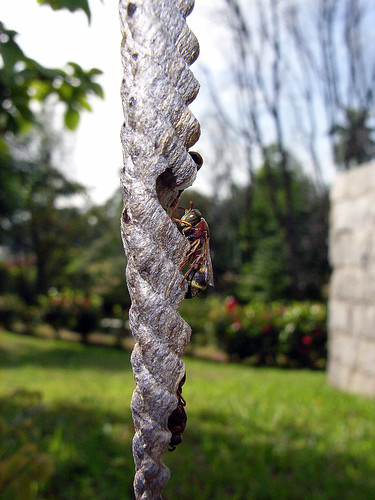
(Photo by Chee Kong)

(Photo by Chee Kong)
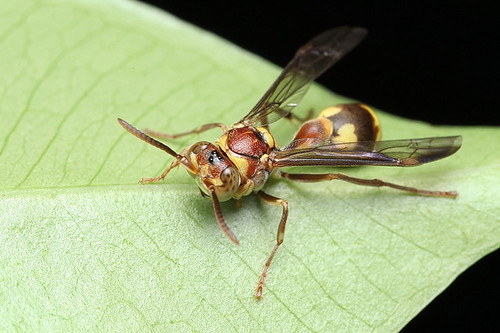
(Photo by James)
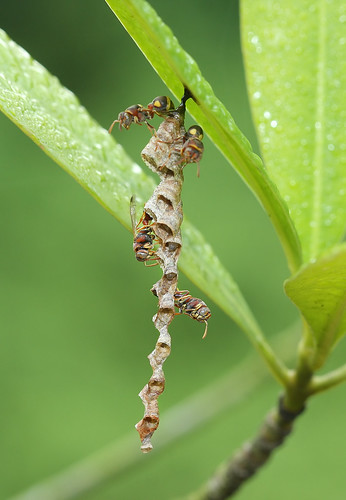
(Photo by kampang)

(Photo by Elite77_Macro)
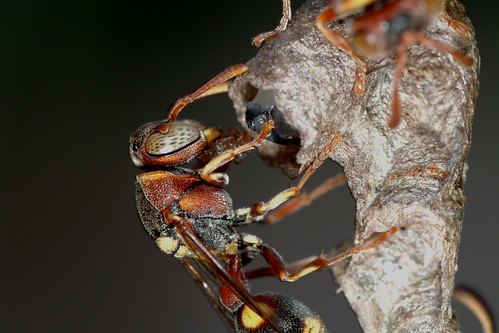
(Photo by Tiomanese)

(Photo by y_leong23)
![Vespidae [ Paper Wasp ]](http://farm6.static.flickr.com/5011/5495154679_fc1147ebc5.jpg)
(Photo by glenespn - photography)
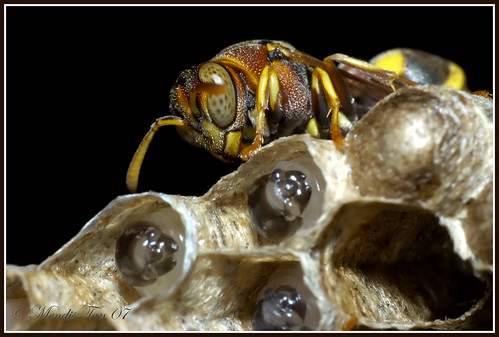
(Photo by Mendis)
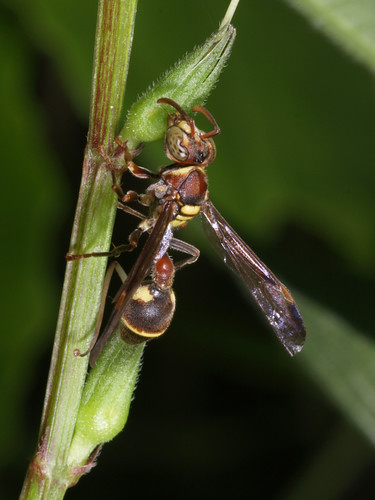
(Photo by terraincognita96)
While searching for relevant images for this post, I discovered that the shape and structure of the nest of the banded paper wasp is identical to that of the brown paper wasp (Ropalidia revolutionalis) from Australia.

Nest of brown paper wasp, Australia;
(Photo by dark orange)
The strange shape of the nest raises a number of questions. Why the long rope-like shape? There have to be certain advantages that are worth the risk of having the entire nest becoming dislodged and falling off, given that it is anchored only at a single point. Also, not all nests built by this species take on this shape; many nests are more normal-looking combs that hang from twigs and leaves. Having the entire nest dangling from a short petiole or stem is seen as a possible deterrent against raids by ants; since worker ants are flightless, it is easier for the wasps to defend their colony if the ants can only gain access via a single route. In fact, the wasps even apply ant-repelling secretions onto the petiole, thus further enhancing the protection of the nest from ants.
But why the long rope-like shape? Another possible reason that I just thought of while writing this post is that the nest is constructed in this manner so as to avoid another predator, one that is capable of attacking in large numbers like ants, and has the added advantage of flight.
Hornet attacking paper wasp nest, Thailand;
Larger wasps such as the greater banded hornet (Vespa tropica) will prey on the colonies of smaller wasp species, raiding nests and feeding on the helpless larvae and pupae, which they will subsequently regurgitate to feed their own young. In fact, it appears that this is the primary prey of the greater banded hornet. The Black-tailed hornet (Vespa ducalis) of East Asia is even more specialised; it preys almost exclusively on the nests of paper wasps.
Black-tailed hornet raiding nest of yellow paper wasp (Polistes rothneyi), Japan;
I would not be surprised if the long, rope-like nest of Ropalidia fasciata is a defence mechanism to deter raids by large hornets, which would probably find it difficult to land on the nest and launch an effective attack due to their size and weight. Also, the aggressive behaviour displayed by the small adults when the nest is touched might not only serve to deter would-be nest predators, but also drive away large animals which might clumsily dislodge the nest or cause it to fall off.
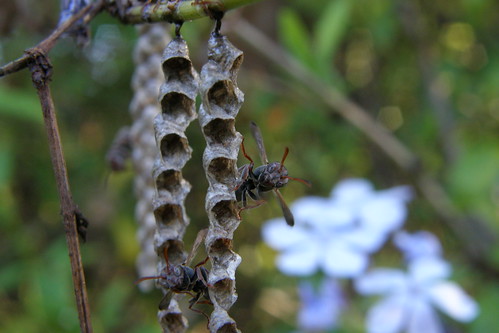
Nest of brown paper wasp, Australia;
(Photo by Brissy Girl - Jan.)
However, this paper on the nest construction of banded paper wasps states a much simpler reason for such a shape; given that the nest is attached to the substrate at a single point, the best way to build more cells and expand the nest is to continue adding cells to the bottom edges. The back of the comb serves as the 'backbone' of the nest and distributes the weight evenly in the vertical plane; expanding the nest horizontally by adding cells to the sides would make the nest more unstable due to differences in weight on both sides, and place strain on the petiole.

Nest of brown paper wasp, Australia;
(Photo by terraincognita96)
Not all Ropalidia paper wasps construct such nests; as this page shows, there is a wide variety of nesting habits present within the genus.
In Singapore, there is another relatively common species of Ropalidia; this is Ropalidia sumatrae, which for convenience sake I will call the Sumatran paper wasp.
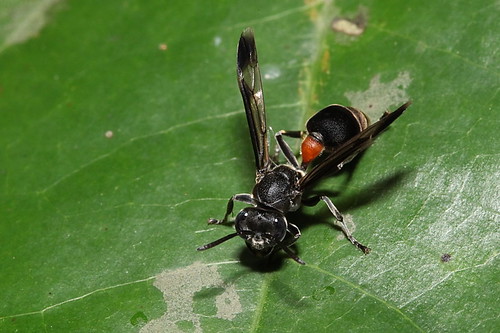
(Photo by James)
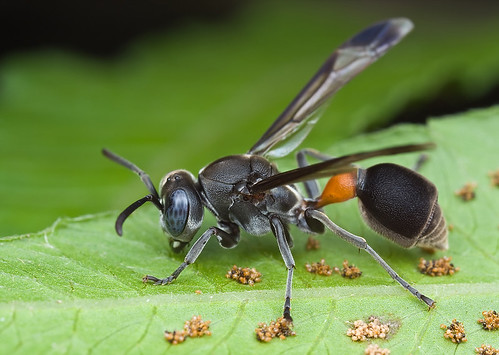
(Photo by Kurt (orionmystery.blogspot.com))
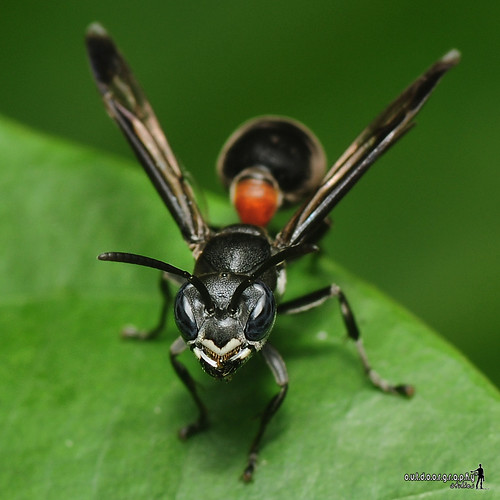
(Photo by Sir Mart Outdoorgraphy™)
Unlike the banded paper wasp, the Sumatran paper wasp nests in much larger colonies; a local sighting documents a large swarm within a cavity in a tree. This suggests that this species nests in holes, and is a swarm-founding species, in which new colonies are formed by fission of pre-existing colonies; after being fertilised, a queen leaves the colony she was born in, bringing with her a swarm of workers that quickly establish and build a new colony.
This is in stark contrast to that of the banded paper wasp, which practises independent-founding; a queen starts a new colony from scratch on her own, unassisted by any workers. In some cases, she may build the colony together with other fertile females, who will share reproductive and worker duties until the colony produces enough workers. In such species, the workers themselves may even be fertile. Colonies of these species remain small, and never attain the sizes seen in the swarm-founding species.
Indeed, as stated in this book, the diversity of nesting habits in Ropalidia paper wasps means that they are the subject of study, as they may reveal clues to the evolution of eusocial insects.
While I am fairly certain that the wasps I saw belong to the genus Ropalidia, there is also a possibility that they are another species, the tropical paper wasp (Polistes stigma), which shares a similar appearance with the banded paper wasp, besides being slightly larger (14 millimetres in length compared to 10 millimetres or less for Ropalidia). However, the photos showing the shape of the nest indicate that it is very different from that of the banded paper wasp, which makes me skeptical that this is the correct identity.
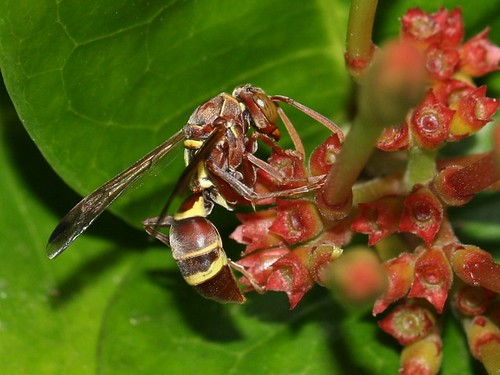
Tropical paper wasp, Australia;
(Photo by Malcolm NQ)
Hopefully, the wasp colony at my workplace will be allowed to survive; last year, a hornet nest in another part of my workplace had to be destroyed because it was too close to an area with high human traffic.
Update (12th May): Rene has posted a Facebook photo album documenting the banded paper wasp colony in her balcony, with much better photos than the ones I took.